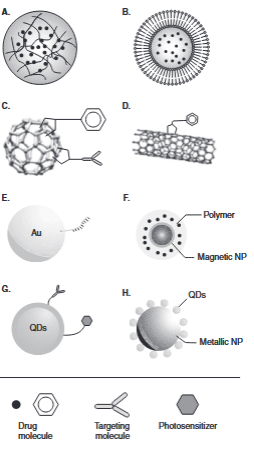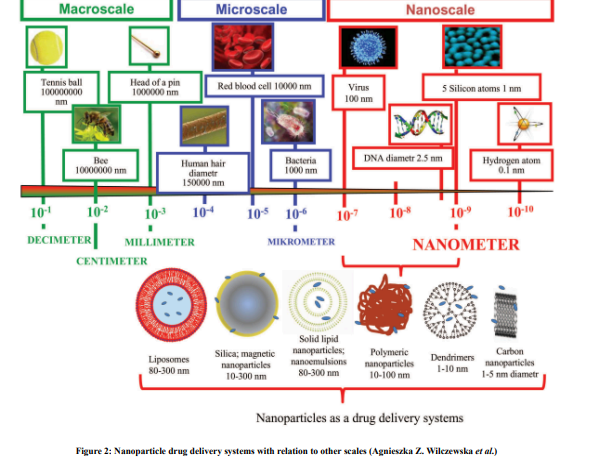Investigate the potential of nanotechnology in drug delivery systems, exploring how nanoparticles can enhance the efficacy and reduce the side effects of pharmaceutical compounds - EXPLORASCOPE OLYMPIAD WINNER
Saad Hamed • 2024-05-02
Nowadays, drugs are used to improve the health condition of people. However, there are some problems in drug delivery and terms of drug efficacy and side effects. Nanotechnology is the solution to the above problems. Researchers have used nanotechnology to create innovative nanocarriers and drug delivery systems that effectively deliver drugs to their target sites.
Research Methodology: This study relies on secondary data obtained from published research papers and review articles available through Google Scholar. Several research methods were used, and this research paper was written after a thorough examination and analysis of the available published data
Abstract: Nowadays, drugs are used to improve the health condition of people. However, there are some problems in drug delivery and terms of drug efficacy and side effects. Nanotechnology is the solution to the above problems. Researchers have used nanotechnology to create innovative nanocarriers and drug delivery systems that effectively deliver drugs to their target sites. For instance, colloidal gold nanoparticles are often employed to deliver anti-carcinogenic drugs. Similarly, integrating ultrasound irradiation with polystyrene nanoparticles and 5-FU injections resulted in significant tumor inhibition as well as full regression in some animals. Furthermore, nanotechnology has the potential to improve efficacy while reducing side effects.
Introduction: The average life expectancy and health conditions of people are improving as science advances, particularly research in pharmaceutical sciences. For the treatment of diseases and to prevent epidemics, drugs are used. Drugs have both chemical and physiological effects on living cells, tissues, organs, or the entire organism. They may kill pathogens such as bacteria, viruses, and fungi. This encapsulates the basic concept underlying all drugs. Drugs were originally derived from plants, but are now artificially synthesized. Modern drug dosage forms face challenges in terms of efficacy, bioavailability, toxicity, biocompatibility, side effects, and inactivity, hindering their development and delivery. In recent times, advanced nanomaterials have been used to address these issues. Advancements in nanotechnology have led to the development of various materials for drug delivery, including polymeric, liposomal, and inorganic. (Figure 1)
Figure 1: Various nanomaterial-based drug delivery platforms. A. Polymeric nanoparticles/micelles B. Liposome C. Buckyball D. Carbon nanotube E. Colloidal gold nanoparticle F. Magnetic nanoparticle G. Quantum dots H. Multifunctional nanoparticle with metallic nanoparticle core (metallic nanoparticle) and semiconductor quantum dots surrounding the shell. Drug molecules can be attached to these carrier systems through encapsulation, mixing, covalent conjugation, or electrostatic and affinity interactions. CNT: Carbon nanotube; NP: Nanoparticle; QD: Quantum dot. (Wen Jiang et al.)
What is a nano drug delivery system? Nanoparticles used for drug delivery are typically less than 100 nm in size and are made from biodegradable materials like polymers, lipids, or metals. Nanostructures have unique physicochemical and biological properties, including increased reactive area and the ability to cross cell and tissue barriers, making them ideal for biomedical applications. In addition, nanoparticles are significantly better taken up by cells than larger micromolecules, making them ideal for transport and delivery. Figure 2 depicts common examples of nanocarriers tested as drug delivery systems.
Effective targeted therapy requires careful consideration of drug conjugation and targeting strategy. Drugs can be adsorbed, covalently attached, or encapsulated in nanocarriers. Covalent linking allows for precise control over the number of drug molecules connected to the nanocarrier, leading to more effective therapeutic compound delivery. Nanocarriers can target specific cells through active or passive mechanisms. The first approach involves attracting drug nanocarriers to the affected site via recognition ligands, such as antibodies, and low-molecular ligands like folic acids and peptides. Physical stimuli, such as temperature, pH, and magnetism, can also be manipulated to achieve the active strategy. Passive targeting occurs when tumor tissues exhibit enhanced vascular permeability and retention (EPR). When drug-nanocarrier conjugates reach diseased tissues, therapeutic agents are released. Controlled drug release from nanocarriers can occur through physiological changes like temperature, pH, and osmolality, or through enzymatic activity. Nanocarriers used in healthcare applications must be biocompatible (integrated with biological processes without causing immune responses) and non-toxic.
Nanoparticles as Drug Delivery Systems to Tumors: Nanoparticles are being studied for early cancer detection and targeted drug delivery. Nanoparticles are extremely small, allowing them to pass through smaller capillaries and be easily absorbed by cancer cells. This results in efficient drug accumulation at the targeted site. The use of biodegradable nanoparticles enables sustained drug release over time. Thus, nanoparticles as drug delivery systems with improved target specificity can overcome the drawbacks of traditional cancer treatment methods. Colloidal gold nanoparticles are frequently employed for anti-carcinogenic drug delivery. Colloidal gold nanoparticles are more biodegradable compared to other nanoparticles. Colloidal gold nanoparticles can bind multiple proteins due to their physical and chemical properties. Colloidal gold nanoparticles were tested as TNF drug delivery vectors in a growing tumor in mice. TNF has been studied for cancer treatment, but it can cause negative effects such as hypotension, organ failure, and even death. The latest study suggests that using colloid gold particles can effectively deliver therapeutic amounts of TNF to kill tumor cells in animals. Gold nanoparticles demonstrated superior cellular delivery and transfection efficiency compared to other gene delivery vehicles. Irina V. Larina et al. examined the cavitation threshold in water suspensions of polystyrene nanoparticles at various concentrations and sizes. They predicted irradiation and nanoparticle parameters that can be utilized in vivo for cavitation-mediated drug delivery in tumors. The study found that combining nanoparticles with ultrasound under specific irradiation conditions can significantly improve cancer chemotherapy with 5-FU in nude mice with human KM20 colon cancer, which is highly resistant to chemotherapy. Combining ultrasound irradiation with polystyrene nanoparticles and 5-FU injections led to essential tumor inhibition and complete regression in some animals. Ultrasound-induced drug delivery may enhance the effectiveness of cancer chemotherapy in patients, according to recent research. But Byung Kook Lee et al. pointed out some important points that small animal studies have consistently demonstrated efficacy in inhibiting tumor development in xenograft models, often outperforming non-nanoparticle formulations as controls. However, in small animal xenograft models, no tumors were entirely eliminated. Small animal model studies typically report data for the first few months or weeks. Although the tumor size may decrease initially, small animals continue to die despite repeated injections. If nanoparticle formulations were successful at treating tumors, they could have been administered repeatedly to completely eliminate the tumor. Unfortunately, no smaller animal research studies have demonstrated such genuine success. The assumptions above regarding the EPR effect and PEGylation of nanoparticles may not accurately reflect in vivo processes, particularly in the body of a human being
Reduction of side effects of pharmaceutical compounds through nanotechnology: Biodegradable nanoparticles can be easily discarded, eliminating potential threats to the biochemical system. Nanoparticles help stabilize drugs before they reach their target site, preventing degradation caused by the stomach's acidic pH. Nanoparticle-based drug delivery has several benefits, including minimized toxicity, controlled release time, faster delivery of higher doses, and altered pharmacokinetics and distribution. Combining this drug with nanoparticles significantly improves its solubility. Traditional solvent-delivery systems can be toxic, but nanotechnology-based drugs are free of these toxins. Facilitating drug movement across barriers like the blood-brain barrier helps prevent drug resistance. Nanoparticles have the benefit of not activating neutrophils in the blood and avoiding the reticuloendothelial system. These characteristics stem from their stability and non-toxicity, making them non-thrombogenic, non-immunogenic, and non-inflammatory. Natural nanomaterials are favored over synthetic nanomaterials due to their ability to deliver multiple active constituents on a single carrier, increase residence time in the body, provide sustained release, and minimize side effects.
Conclusion: Nanoparticles as drug delivery systems are overcoming the drawbacks of conventional methods. Nanotechnology-based drugs improve drug delivery and minimize side effects by improving weak water-soluble drug delivery, delivering drugs through cell- or tissue-specific methods, transcytosis across tight epithelial and endothelial membrane barriers, delivery of large-macromolecule drugs, co-delivery of two or more therapies in combination therapy, and visualization of drug delivery sites.
References:
- Arome Odiba et al. (2016). “Making drugs safer: improving drug delivery and reducing the side effect of drugs on the human biochemical system” Nanotechnol Rev 2016; 5(2): 183–194, DOI 10.1515/ntrev-2015-0055.
- P Prabhakar et al. (2020). “Nanotechnology in Drug Delivery System: Challenges and Opportunities.” Journal of Pharmaceutical sciences and research, Vol. 12(4), 2020, 492-498.
- Byung Kook Lee et al. (2015). “Smart Nanoparticles for Drug Delivery: Boundaries and Opportunities.” Chem Eng Sci., 125: 158–164. doi:10.1016/j.ces.2014.06.042.
- Agnieszka Z. Wilczewska et al. (2012). “Nanoparticles as drug delivery systems.” Pharmacological Reports 2012, 64, 10201037 ISSN 1734-1140.
- Karthikeyan Subramani et al. (2009). “Targeting Nanoparticles as Drug Delivery Systems for Cancer Treatment.” Current Nanoscience Journal, 2009, 5, 135-140.
- Sarabjeet Singh Suri et al. (2007). “Nanotechnology-based drug delivery systems” Journal of Occupational Medicine and Toxicology 2007, 2:16 doi:10.1186/1745-6673-2-16.
- Irina V. Larina et al. (2005). “Enhancement of Drug Delivery in Tumors by Using Interaction of Nanoparticles with Ultrasound Radiation.” Technology in Cancer Research & Treatment Journal, Volume 4, Number 2.
- ZHU YP, WOERDENBAG HJ: Traditional Chinese herbal medicine. Pharm. World Sci. ( 1995 ) 17: 103 -112.
- M. Srinivasarao and P. S. Low, “Ligand-Targeted Drug Delivery,” Chem. Rev., vol. 117, no. 19, pp. 12133–12164, 2017.
- A. Sofowora, E. Ogunbodede, A. Onayade, and C. Dentistry, “ The role and place of medicinal plants in the strategies for disease", Afr J Tradit Complement Altern Med; vol. 10, pp. 210–229, 2013.
- D. M. Teleanu, C. Chircov, A. M. Grumezescu, and R. I. Teleanu, “Neuronanomedicine : An Up-to-Date Overview,” Pharmaceutics, vol. 11, no. 101, pp. 1–23, 2019.
- KATAOKA K, HARADA A, NAGASAKI Y: Block copolymer micelles for drug delivery: design, characterization and biological significance. Adv. Drug Deliv. Rev. ( 2001 ) 47: 113 -131.
- PANYAM J, LABHASETWAR V: Biodegradable nanoparticles for drug and gene delivery to cells and tissue. Adv. Drug Deliv. Rev. ( 2003 ) 55: 329 -349.
- BATIST G, RAMAKRISHNAN G, RAO CS et al.: Reduced cardiotoxicity and preserved antitumor efficacy of liposome-encapsulated doxorubicin and cyclophosphamide compared with conventional doxorubicin and cyclophosphamide in a randomized, multicenter trial of metastatic breast cancer. J. Clin. Oncol. ( 2001 ) 19: 1444 -1454.
- Pison U, Welte T, Giersing M, Groneberg DA: Nanomedicine for respiratory diseases. Eu J Pharmacology 2006, 533:341-350.
- Brannon-Peppase L, Blanchette JQ: Nanoparticle and targeted systems for cancer therapy. Adv Drug Deliv Rev 2004, 56(11):1649-1659.
- Stylios GK, Giannoudis PV, Wan T: Applications of nanotechnologies in medical practice. Injury 2005, 36:S6-S13.
- Yokoyama M: Drug targeting with nano-sized carrier systems. J Artif Organs 2005, 8(2):77-84.
See More Posts
Copyright © 2021 Govest, Inc. All rights reserved.



